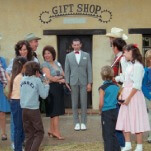Killer Women offers up a fresh take on the Western procedural

Killer Women isn’t bad. It’s not exactly good, but it’s surprisingly engaging for a show that is trying to do just one thing well. The promos for the show are splashy, with a Western flair that emphasizes brooding silhouettes and spattered blood. (They draw heavily from the title sequence for the classic A Fistful Of Dollars.) Executive producer Hannah Shakespeare (who adapted the series from an Argentine crime drama) previously worked on The Playboy Club, and in their messiness and mediocrity, there’s much in common between the two shows.
On one hand, Killer Women is a show about women. Not just the “killer” ones; the main character is Molly Parker (Tricia Helfer), a Texas Ranger who is always struggling to prove that she is the equal of her male colleagues. She has a sister-in-law who tries to get her to wear dresses, a husband she’s trying to divorce, and a gun she knows how to use. On the other hand, it’s a cowboy procedural, about a Texas Ranger on the fractious border between Texas and Mexico. It uses wide shots to get that windswept, desert feel, and the plot integrates ranch hands and drug cartels with enough facility to make the setting believable.
Killer Women is heavily invested in the romance of guns and cowboys (or cowgirls); it’s a show that ostentatiously frames the firearms in the foreground as two lovers have sex in the background. It’s a show that wants to be sexy and fun without thinking too hard about it. On some counts, it succeeds admirably. And because there are more than a few women producing it—including executive producers Shakespeare and Sofía Vergara—the show comes across as a romance about women for women (except for the gratuitous cleavage shots). Even in its splashiness, Killer Women strives to bring something different to a run-of-the-mill procedural.
The crime of the week in the pilot is a soapy, pulpy murder: A Latina woman wearing a very short red dress and red heels walks into a church with a gun, just as a (white) couple at the altar is pronounced husband and wife. She’s in red. The bride is in white. The murderess stalks up the aisle, raises the gun, and shoots the bride point-blank. She’s gone almost as quickly, leaving just a pair of red high heels in the dust. It would be easy to assume a crime of passion—most of the (male) police force assumes so—especially after she confesses to it, with a sultry accent out of a James Bond movie. After all, the reasoning seems go, she was wearing that red dress. The semiotic resonance of such a decision seems clear, especially for a murder on television, which trades on visual tropes just to keep the story moving.








































